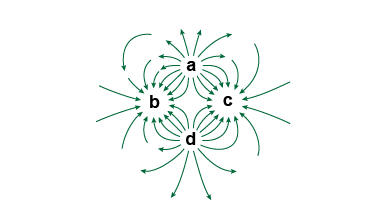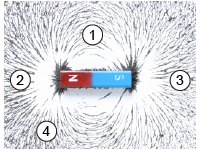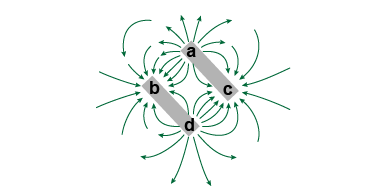 Can an electrically neutral object be polarized? Can an electrically neutral object be polarized?
 Sketch the electric field around three identical, negatively charged particles, located at the corners of an equilateral triangle. Sketch the electric field around three identical, negatively charged particles, located at the corners of an equilateral triangle.
 Sketch the electric field between two particles, one with charge +2 μC and the other with charge +1 μC. Sketch the electric field between two particles, one with charge +2 μC and the other with charge +1 μC.
 Xiu and Yves were preparing to make a sensitive measurement of electric charge using an electroscope. They noticed, however, that every time Yves brought his tablet computer close to the electroscope to take notes, the leaves of the electroscope would spread apart. What was going on? Xiu and Yves were preparing to make a sensitive measurement of electric charge using an electroscope. They noticed, however, that every time Yves brought his tablet computer close to the electroscope to take notes, the leaves of the electroscope would spread apart. What was going on?

 What four electric charges create the electric field in the diagram shown? Identify which are positive and which are negative. What four electric charges create the electric field in the diagram shown? Identify which are positive and which are negative.
- Electric potential states how much energy is available per unit _______.
- mass
- charge
- current
- capacitance
- Two capacitors are each charged by a 5 V battery. If the capacitance of Capacitor A is twice that of Capacitor B, what is the ratio of the charge that each holds?

- Eva has two capacitors, each with a capacitance of 2 μF. She would like to install the equivalent of one 4 μF capacitor into a circuit she is building. Should she put the two capacitors in series or parallel?
| |

- For the bar magnet in the figure, draw the direction the compass needle will point for each of the four locations identified in the figure.
 A large bar magnet (mass of 0.4 kg) exerts a 5 N force on a small bar magnet (mass of 0.1 kg) located 20 cm away. Calculate the force exerted by the small bar magnet on the large one. A large bar magnet (mass of 0.4 kg) exerts a 5 N force on a small bar magnet (mass of 0.1 kg) located 20 cm away. Calculate the force exerted by the small bar magnet on the large one.

 Two bar magnets create the magnetic field in the diagram. Which are north poles and which are south poles? Two bar magnets create the magnetic field in the diagram. Which are north poles and which are south poles?
 Two hikers consult a map and determine that, at their location, the magnetic declination is 10° west. If they hike 1 km north according to their compass needle, then how far off will they be from 1 km true north? Two hikers consult a map and determine that, at their location, the magnetic declination is 10° west. If they hike 1 km north according to their compass needle, then how far off will they be from 1 km true north?
 The magnetic force Fm between two bar magnets was measured for various separations d between them and tabulated below. Does the magnetic force follow an inverse-square law? Why or why not? Draw a graph to justify your conclusion. The magnetic force Fm between two bar magnets was measured for various separations d between them and tabulated below. Does the magnetic force follow an inverse-square law? Why or why not? Draw a graph to justify your conclusion.
Magnetic force between two bar magnets Distance d
(cm) | Force Fm
(N) | | 5.0 | 3.0 | | 10.0 | 0.38 | | 15.0 | 0.11 | | 20.0 | 0.047 | | 25.0 | 0.024 |
|

